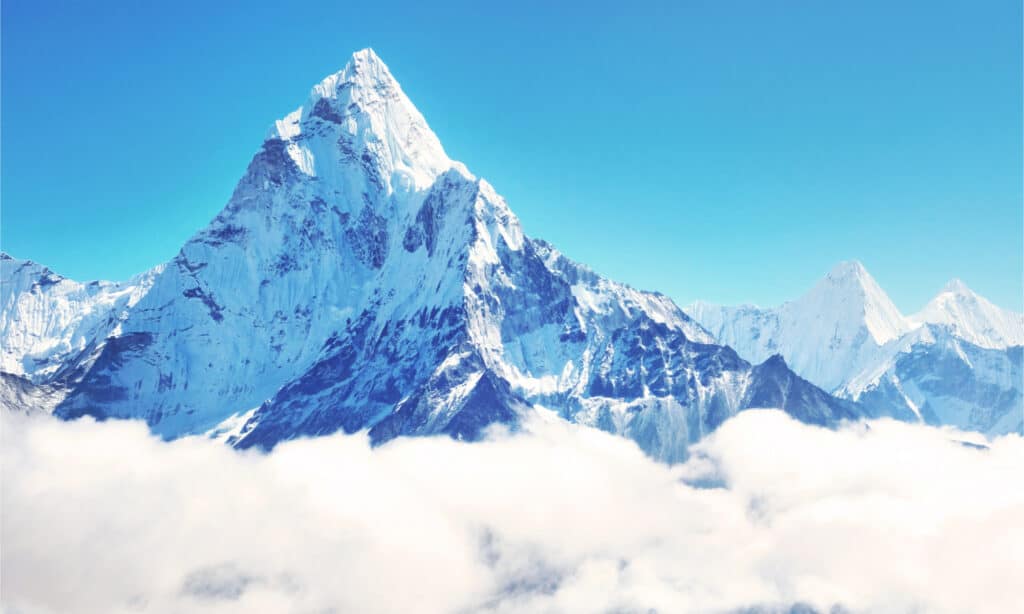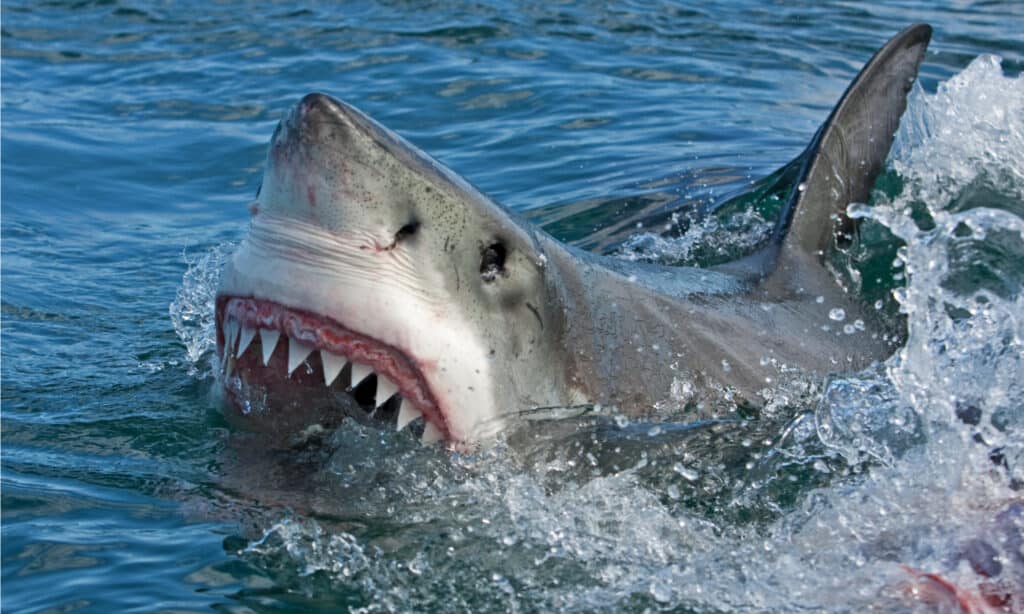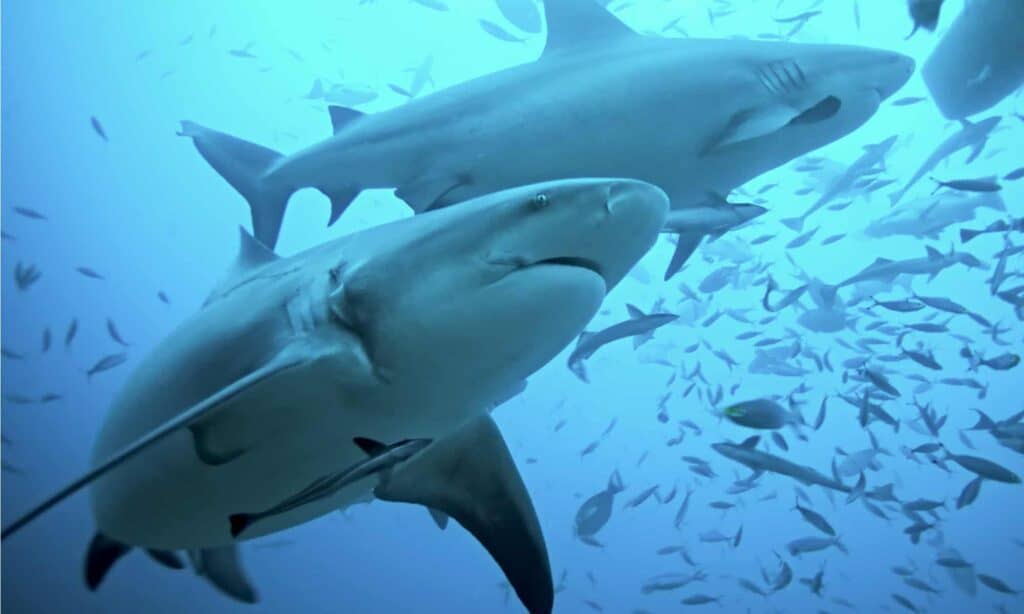Although it might seem like a simple question, determining whether climbing Mount Everest or experiencing a shark attack is more dangerous is more complex than it might seem. A host of factors influence both situations, and these factors must be considered in full to decide the answer. While no one would want to become susceptible to dangers in either circumstance, discovering what makes Mt. Everest and shark attacks dangerous could be the key to avoiding their threats. So let’s discuss which is more dangerous in climbing Mount Everest vs. shark attack!
Background of Mount Everest

Mount Everest is the largest mountain in the world, but climbers die every year while attempting to reach its summit.
©Vixit/Shutterstock.com
Many know Mount Everest as the largest mountain in the world, standing at over 29,000 feet in the Himalayas. While some consider Mt. Everest to be the adventure of a lifetime, others see it as a death wish. In fact, past 26,247 feet begins the “death zone,” which is, unarguably, the most dangerous portion of the climb. High elevation, freezing temperatures, erratic weather patterns, avalanches, and falling opportunities all make the “death zone” live up to its name. Therefore, if a climber ventures to tackle this peak, they should take all precautions necessary and train properly beforehand.
Preparing to Climb Mount Everest
In preparing to climb Mount Everest, a person should consider several factors. First, they should consider rest of utmost importance on the journey to avoid problems like altitude sickness. Moreover, sleeping at lower altitudes can reduce the risk of altitude sickness.
Climbing Mt. Everest in the right season is crucial, too. Climbers should aim to begin their hike between April and May when weather and temperature conditions are most favorable. Likewise, temperatures on Mt. Everest are extremely cold, so proper attire for staying warm is crucial.
Consulting guides about numerous dangers like avalanches and ice falls is another way to ensure safety on the route. Doing a vast amount of research into reliable guides and agencies is necessary in guaranteeing that a climber is receiving expert advice rather than novice consultation, which might lead them down a dangerous path.
Dangers on Mount Everest

There are many dangers awaiting climbers on Mount Everest, such as adverse weather conditions and avalanches.
©Vixit/Shutterstock.com
Climbing Mount Everest comes with a host of dangers, which can be debilitating and even fatal. Being aware of dangers on the peak is crucial to reaching and returning from the summit. Below lists some notable risks of making the climb.
Temperature
Temperatures on Mount Everest are always freezing. At the top of Mt. Everest, the temperature measures below 0ºF during all seasons. In the most extreme cases, temperature has been known to drop to -76ºF. In April and May, when weather conditions are most favorable for climbing, average temperatures at the summit measure -23.8ºF and -13ºF, respectively.
Weather Patterns
Unfortunately, Mount Everest is prone to erratic and unreliable weather conditions. While a person on the route might have experienced favorable weather in the beginning, they are likely to face horrible and unpredictable storms throughout their journey.
Altitude Sickness
As altitude increases, climbers lose necessary oxygen, and air pressure decreases. In most cases, supplementary oxygen is necessary to continue to the journey. Two types of altitude sickness are High Altitude Cerebral Edema and High Altitude Pulmonary Edema. Neurological problems or a coma can be a result of both instances.
Falls
Falls can happen almost anywhere and at any time. One negligent move by a climber can result in death. For instance, climbers should always double check that their carabiners are fastened correctly and that their knots are taught and strong. By taking protective measures like these, the risk of fall decreases, but it will always be present.
Avalanches
Many opportunities for avalanches exist on the expedition to the summit of Mount Everest. The North Col and South Col are both areas susceptible to avalanche occurrences. Furthermore, an area nicknamed “Suicide Passage” is prone to avalanches, too.
Background of Shark Attacks

There were 73 unprovoked shark attacks worldwide in 2021 alone.
©Martin Prochazkacz/Shutterstock.com
In 2021, there were 73 occurrences of unprovoked shark bites worldwide. On the other hand, there were 39 provoked bites reported. Unprovoked bites occur without human initiation of interaction with a shark. Provoked bites are just the opposite. Florida is the state within the United States in which the largest number of unprovoked shark bites occurred in 2021. Florida totaled 28 unprovoked shark bites. Coming in second place, Hawaii totaled six unprovoked shark bites in 2021.
Although these figures may seem intimidating, sharks don’t intend to attack humans when unprovoked. In fact, humans are not something that a shark wants to eat in the first place. Sharks can misunderstand certain situations, and this misunderstanding can lead to shark attacks. For example, a shark might see a human in the water and mistake it for an animal that is a part of their diet. The shark might attack the human but quickly realizes its mistake.
Furthermore, humans are more of a threat to sharks than sharks are to humans. Humans have been known to hunt sharks for food and product manufacturing. Overfishing for sharks can lead to a decrease in certain shark species’ populations. Therefore, while most people think that they should be looking out for the dangers of a shark attack, the sharks should be looking out for human dangers!
Avoiding Shark Attacks
There are numerous ways to lower the risk of an unprovoked shark attack. Below list five of the best steps to take in ensuring safety in ocean waters.
- Don’t swim alone! Sharks probably won’t come up to a pair or group of people. On the other hand, sharks might swim near a person who is swimming alone.
- Stay close to shore. Swimming closer to the shore allows someone the opportunity to contact support in the case of a shark attack.
- Swim during daylight. Sharks usually feed at night, so swimming during the nighttime is not a safe choice.
- Be careful in waters with low visibility. If you can’t see in the water, a shark probably can’t see you either, meaning the possibility of an accidental shark attack increases.
- Avoid splashing in the water. Sure, splashing around in the ocean and diving deep into the waves can be a fun activity. However, splashing can confuse a shark into believing that a swimmer might be an animal of prey.
Likelihood of Death from Climbing Mount Everest vs. Shark Attack

Although it might seem as though sharks are more deadly, the actual chances of an attack are very low.
©Martin Prochazkacz/Shutterstock.com
In 2021, one death resulted from a shark attack in the United States in California. Across the globe, nine fatalities occurred from shark attacks in the United States, Australia, Brazil, New Caledonia, New Zealand, and South Africa. Chances of fatality from a shark attack are reported to be 1 in 4,332,817. By comparison, chances of dying in a car accident are 1 in 84. Overall, the likelihood of shark attack is extraordinarily low. In fact, chances of being bitten by a shark are decreasing.
On Mount Everest, four people died in 2021, and 310 people have died on the climb in the last century. Mt. Everest averages five fatalities every year. Approximately 1% of those than venture to climb Mt. Everest die on the route, and this figure has remained consistent since 1990. However, the success rate of climbers who reach the summit of Mt. Everest has doubled since 1990. Most fatalities result from avalanches or accidental falls.
Climbing Mount Everest vs. Shark Attack: Which is More Dangerous?
Overall, climbing Mt. Everest is more dangerous than experiencing a shark attack. Although shark attack fatalities were more frequent than deaths on Mt. Everest in 2021, dangers on Mt. Everest are more numerous than a single shark bite. In addition, climbing Mt. Everest requires preparation and endurance, meaning that not just anyone can attempt to reach the summit. However, anyone can become victim to a shark attack. Therefore, figures alone aren’t necessarily comparable in determining which circumstance is more dangerous than the other. All contexts must be considered when deciding whether climbing Mt. Everest or a shark attack is more dangerous. In the end, threats on Mt. Everest are notably more dangerous than a single shark attack.
Up Next
- The Deadliest Shark Attack in Human History
- Discover the Largest Mountain in the World
- Where are the Most Shark Attacks in the World?
- The Largest Mountain Range in the World
The photo featured at the top of this post is © Ramon Carretero/Shutterstock.com
Sources
- Top China Travel, Available here: https://www.topchinatravel.com/mount-everest/the-climate-of-mount-everest.htm#:~:text=Temperature%20of%20Mount%20Everest,bit%20warmer%20in%20the%20day
- Peak Climbing Nepal, Available here: https://peakclimbingnepal.com/dangers-of-climbing-mount-everest/
- National Oceanic and Atmospheric Administration, Available here: https://oceanservice.noaa.gov/facts/sharkseat.html#:~:text=Sharks%20have%20been%20known%20to,than%20we%20do%20of%20them
- Florida Museum of Natural History, Available here: https://www.floridamuseum.ufl.edu/discover-fish/sharks/how-to-avoid-shark-attacks/
- Florida Museum of Natural History, Available here: https://www.floridamuseum.ufl.edu/shark-attacks/yearly-worldwide-summary/
- Wikipedia, Available here: https://en.wikipedia.org/wiki/List_of_people_who_died_climbing_Mount_Everest
- Chloe Mayer, Available here: https://www.newsweek.com/mount-everest-deaths-new-rules-1711652#:~:text=On%20average%2C%20around%20five%20climbers,the%20global%20news%20agency%20AFP
- Florida Museum of Natural History, Available here: https://www.floridamuseum.ufl.edu/shark-attacks/odds/compare-risk/death/
- Wikipedia, Available here: https://en.wikipedia.org/wiki/List_of_Mount_Everest_death_statistics
FAQs (Frequently Asked Questions)
Where is Mount Everest located?
Mount Everest is part of the Himalayas and sits on the border of China and Nepal.
How frequent are shark attacks?
Shark attacks are infrequent. In 2021, 9 fatalities resulted from shark attacks.
How many people have died on Mount Everest?
Approximately 310 people have died on Mount Everest, and an average of five people die on Mt. Everest annually.
Thank you for reading! Have some feedback for us? Contact the AZ Animals editorial team.






